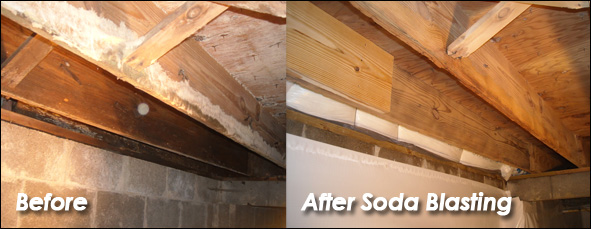Controlling Crawlspace Problems
Controlling moisture is the key to eliminating problems with mold, pests, and wood rot in your crawlspace. Many types of crawlspaces have moisture problems. Even a crawlspace with a concrete slab floor can be excessively damp. All crawlspaces are built differently so we will evaluate your conditions and come up with a plan that will be specifically designed to address and improve any crawlspace problem your home may be experiencing.
The biggest problem most people have is excess moisture under the home. Moisture in the crawlspace can be attributed to water passing through or under the foundation wall, insufficient grade and drainage, overflowing gutters, and damaged or missing foundation drains or seals. Any of these conditions can produce a prime environment for mold to grow. Mold is usually most visible on the wood beams and joists; however, mold can grow on any organic surface including the ground, plumbing pipes, and HVAC ducts. Having excess moisture in a crawlspace can also cause structural damage to your home’s wood framing. Wood decaying fungus is very common in wet crawlspaces. Wood decaying fungus deteriorates the wood causing wood rot which leads to structural damage of the home.
Wood Decaying Fungus
Our natural environment in Alabama maintains a normal humidity at 80% or higher. The concern with this is that mold naturally self generates at 73% humidity. Often times, this is why mold grows in the crawlspace without any apparent problem. The most common mold that grows in the crawlspace in the South is wood decaying fungus. This mold is not a natural airborne irritant; however, its purpose is to consume Southern Yellow Pine. The concern is that SYP, Southern Yellow Pine, is the most commonly used material to construct the floor. If this mold grows on the floor it can cause significant structural damage in as quickly as 3 years but most generally within 15 years.
Secondary Mold Conditions
Often times people confuse wood decaying fungus and molds that are airborne irritants or environmental conditions. Most commonly, termite contractors, HVAC contractors, and other professionals that do not understand mold refer to these conditions as common or un-harmful crawlspace molds. This representation couldn’t be farther from the truth. Molds growing in the crawlspace are naturally drawn into the living areas of the home and can effect indoor air quality. These molds require the same cleaning and attention as molds found in the interior of the home.
Crawlspace Mold Removal by Soda Blasting
Soda Blasting kills organic contaminates and provides for a complete mold spore removal. With this service, your crawlspace will smell clean again, mold and mildew stains will be removed, and your home will be a safe and healthy environment for your family. Soda Blasting is environmentally safe and today’s most requested cleaning method.
 This method entails a high-pressure compressed-air spray using a baking soda abrasive. We’ve found that this method cleans irregular crawl space floor surfaces which would otherwise be both labor intensive and impossible to clean by manual scrubbing and vacuuming.
This method entails a high-pressure compressed-air spray using a baking soda abrasive. We’ve found that this method cleans irregular crawl space floor surfaces which would otherwise be both labor intensive and impossible to clean by manual scrubbing and vacuuming.
This revolutionary technique is four times faster than hand sanding and brushing, and leaves wood with what can best be described as a “like new” appearance. The process also provides a more thorough cleaning than previous techniques and is environmentally safer than chemical cleaning.
Cleaning with Chemicals
Some jobs require chemicals for pretreatment, removal, and/or prevention. We offer a full line of chemical treatments for jobs big and small. Visit Our Products page for more information on our line of specialized mold remediation products.
Solutions to Crawlspace Moisture
After we have identified and removed the mold, we must eliminate moisture in the crawlspace In order to prevent new mold from growing. There are two solutions to doing so:
1. Return to our grandfather’s way of building, which included open crawlspaces that have sufficient ventilation and UV light. Additional improvements that ensure mold won’t grow include proper grade, drainage, gutters, and landscaping. The old way always works better than an engineered process. The old way includes naturally drying the soil under the home with proper construction techniques. The simple proof in this time-tested process is houses that have dry dirt in their crawlspaces do not have mold.
2. An engineered, environmentally controlled crawlspace should only be considered when there is no other reasonable option. An engineered crawlspace includes advanced crawlspace liners, advanced foundation seals, column improvements, and dehumidifiers. The purpose of the crawlspace liner is to encapsulate or seal the exterior environment or soil to block the effects of humidity. The dehumidifier is designed to replace natural ventilation with the intent to maintain the environment in the crawlspace.
Please view Our Products for more information on the crawlspace liners and dehumidifiers we use in our crawlspace solutions.
Free Crawlspace Check!
Possible signs of excessive crawlspace moisture include:
- Standing water or mud on dirt floor after a heavy rain
- Efflorescence on crawlspace walls
- Signs of rot and rust in crawlspace
- Unpleasant musty odors
- Respiratory discomfort, headaches, and illnesses, such as allergies and asthma
- Insect and other pest infestations
- Mold and mildew on walls and floors
- Peeling paint on home exterior
Give us a call for a FREE Crawlspace Check! Chris Rose, our crawlspace expert, will come by your home to take a look at your crawlspace to see if you have a problem.
If you do have a problem, Chris can put together a detailed Evaluation, Scope of Work, and Estimate. Our custom evaluations start at $300. We will design a custom plan for you to fix any and all issues your home might have. If you choose to let us complete the work that Chris has laid out, the Evaluation, Scope of Work, and Estimate is FREE!
